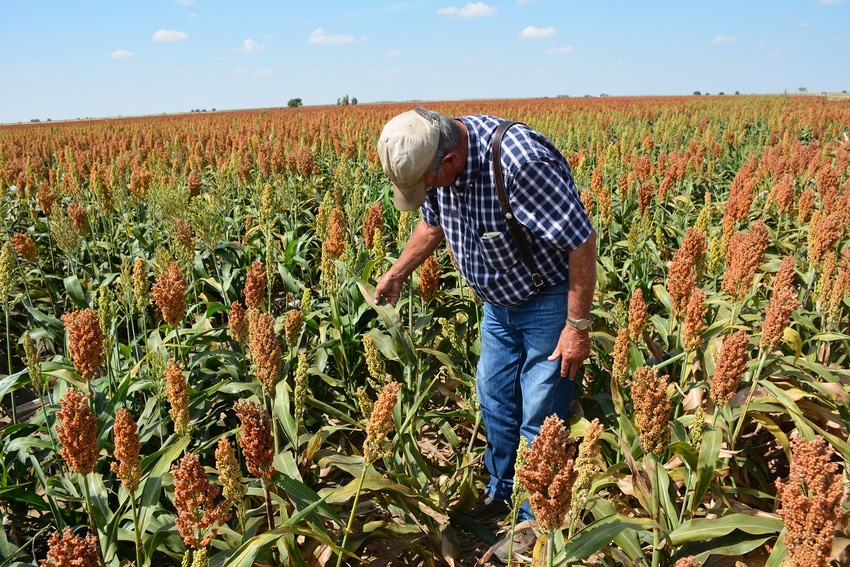
A new sugarcane aphid treatment decision tool developed by Texas A&M AgriLife Extension specialists in Corpus Christi promises to help grain sorghum producers decide when to justify treatment for a sugarcane aphid infestation without causing input costs to exceed estimated profits.
With a grant from Southern Risk Management Education Center at the University of Arkansas last year, Mac Young, an extension program specialist at Texas A&M AgriLife Research and Extension Center in Corpus Christi, and Levi Russell, an extension agriculture economist at the Center, worked cooperatively to develop and test the tool.
What they hoped to achieve was a simple tool that could be used to take the guess work out of when it becomes economically productive to initiate sugarcane aphid treatments in a specific sorghum crop.
For the latest on southwest agriculture, please check out Southwest Farm Press Daily and receive the latest news right to your inbox.
The Texas Coastal Bend region is the largest grain sorghum production area in the nation and one of the first places where the sugarcane aphid (SCA) was found. In 2013, the arrival and proliferation of the aphid was so intense and fast spreading that serious economic losses resulted.
Since then the aphid has spread rapidly into the Southeast and the Great Plains, and already entomologist are warning this could be another problematic year for SCA.
"The development of this tool was made possible through the Southern Extension Risk Management Education Competitive Grants program, and we designed it to be fairly simple to use. It is an Excel-based tool that can be called up and used on any iPhone or other mobile instrument or computer with an Internet connection, even in the field," explained Young.
It is a spreadsheet that farmers can use for their specific operation by plugging in information about their field and circumstances. For example, the tool uses information about the producer’s cost of treatment, grain sorghum yield and price, and marketing costs to determine the number of aphids per leaf required for profitable treatment.
GROWER DATA
By entering their chemical and application costs, harvest costs, current sorghum price, and other information, the spreadsheet formulas will convert the results in the tool, making it specific to the producer's crop.
"Once a producer has filled in all the information relative to his crop and operation, then the tool will either recommend it is or is not cost effective to treat," Young said. “The very purpose of the tool is to help producers make an economic decision whether or not they need to spray, and when they should spray, based upon potential for yield loss versus the economics of higher input costs required if the tool recommends treatment.”
Young and Russell agree that the tool can be useful not only for Coastal Bend producers but also for grain sorghum farmers in a much greater geographic area.
“Sorghum producers in the Rio Grande Valley will benefit from this tool as well as grain producers around Uvalde and across the Texas Winter Garden, but it can also be used in neighboring Louisiana, around San Angelo, even the Blacklands of Texas,” Young stressed. “It is even a useful tool as far north as Oklahoma.”
While sugarcane aphid damage has been problematic in South Texas over the last three years, entomologist warn the spread of the pest and the potential damage it can cause to a sorghum field is spreading north and east rapidly.
PEST IS SPREADING
Mike Brewer, field crop entomologist at the Texas A&M Extension Research Center in Corpus Christi, reported last year that sugarcane aphids have been found as far north as Kansas, and they continue to spread.
A mild winter across much of the Southwest has allowed sugarcane aphids to survive the winter months on Johnson grass, adding to the worries that aphid populations could explode in some areas this year.
“A producer's best defense against sugarcane aphids is an aggressive scouting program. Keeping up with the number of aphids on a sorghum leaf offers the best evidence. While you don't want to spray until aphid numbers reach a certain threshold, neither do you want to wait too long, and we have seen this happen in the past. Many producers are surprised with just how fast aphid populations can grow under the right conditions, so systematic scouting of your fields is necessary,” Brewer told sorghum producers in a meeting last year.
Young says Brewer and Robert Bowling, also an AgriLIfe entomologist, have conducted some of the most comprehensive research on the sugarcane aphid available to date, and that work is well represented in the new tool.
ECONOMIC THRESHOLDS
“We hear a lot about the threshold for SCA populations but I prefer to think of them as economic thresholds. They are the same thing, but it helps to understand that the decision to spray or not spray is one based upon whether it is economical to spray or not. That's the purpose of the tool based upon each producer's specific crop,” Young said.
In other words, the tool tells the producer when it becomes economically viable to spray in order to prevent economic loss. If spraying is not a viable economic alternative, there is no reason to spray. But if spraying means you would make more by preventing yield loss versus the extra input cost, then that is when it becomes an advantage.
Decision Tool for Sorghum can be downloaded.
A scouting card can be downloaded to help in your scouting efforts.
About the Author(s)
You May Also Like




